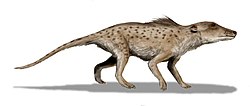Pakicetus
Pakicetus is a genus of extinct cetaceans found in the early Eocene of Pakistan 55.8 ± 0.2 - 33.9 ± 0.1 million years ago (mya). The strata where the fossils were found was then on the coast of the Tethys Sea.[1]
| Pakicetus Temporal range: early Eocene, 49–33.9 mya
| |
|---|---|

| |
| Scientific classification | |
| Domain: | |
| Kingdom: | |
| Class: | |
| Order: | |
| Suborder: | |
| Family: | |
| Genus: | Pakicetus
|
| Binomial name | |
| Pakicetus inachus | |
Description
The first fossil, a lone skull, was thought to be of an entelodont known as Daedon, but Gingerich and Russell recognized it as an early cetacean. It had characteristics of the inner ear which are found only in cetaceans: the large auditory bulla is formed from the ectotympanic bone only. This suggests that it is a transitional species between extinct land mammals and modern cetaceans.[2]
Complete skeletons were discovered in 2001. Pakicetus was primarily a land animal, about the size of a wolf, and very similar in form to the related Mesonyx.
Pakicetus Media
Related pages
References
- ↑ Gingerich, Philip D. & Russell, Donald E. 1981. Pakicetus inachus, a new Archaeocete (Mammalia, Cetacea) from the early-middle Eocene Kuldana Formation of Kohat (Pakistan). Contributions from the Museum of Paleontology, The Museum of Michigan. 25 (11): 235–246.
- ↑ Gingerich, Philip D. et al 1983. Origin of whales in epicontinental remnant seas: new evidence from the early Eocene of Pakistan. Science. 220 (4595): 403–6. [1]. PMID 17831411.

